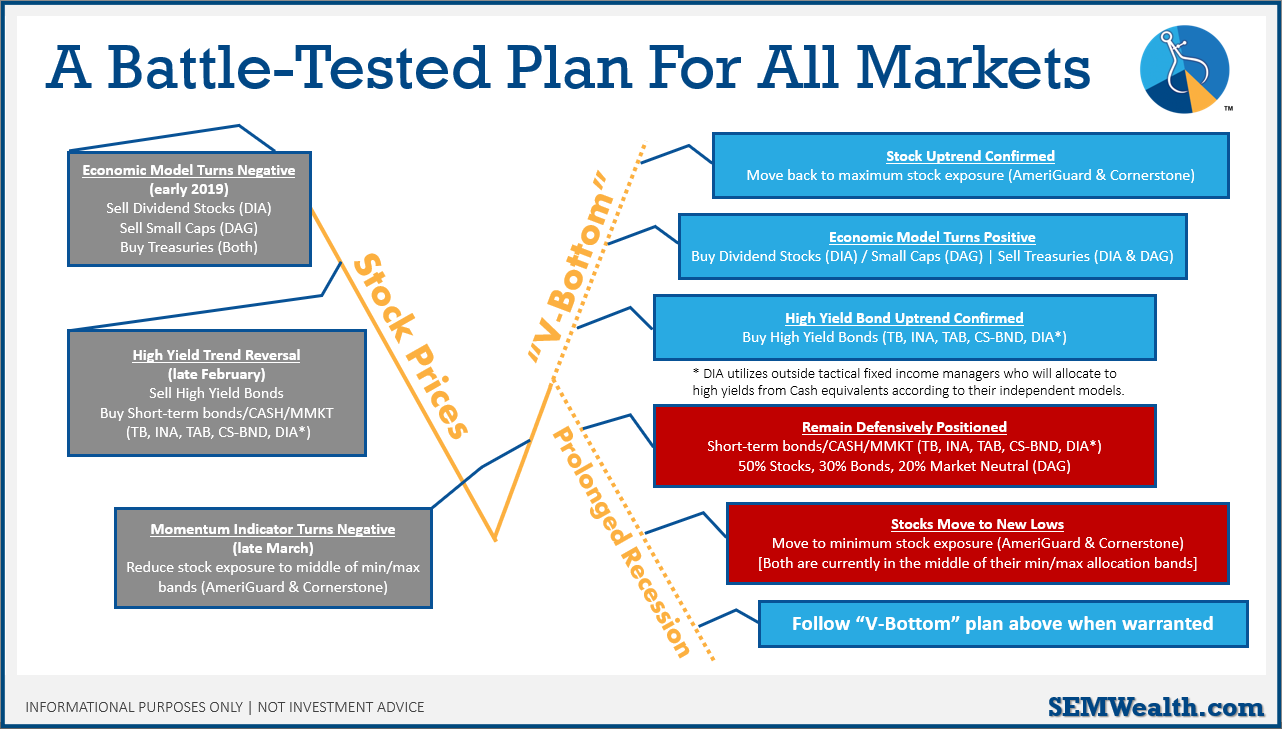We are all being bombarded with charts, data, projections, opinions, and webinars on what will happen with the economy and the stock market. Advisors and investors alike are scrambling to come up with a plan. As you work on them, here are 10 thoughts to consider:
1.) Clearly the stock market and our economy has never faced a crisis like we are right now. Since our founding in 1992, SEM has been through plenty of "unprecedented" events. The "cause" of the panic may be different, but the human reaction is not.

2.) We are seeing two primary reactions from both investors and advisors:
- they are paralyzed and don't know what to do, so they are doing nothing
- they are hoping this will be over soon and we'll go right back to where we were in January 2020.

3.) SEM's systems have once again been battle-tested. While we've never had a faster 30% sell-off in the stock market to test against, every system performed exactly as we expected. For the past six weeks, our portfolio management team has spent most of our time stress testing all of our systems, evaluating all of our investment fund options, and running through scenarios we've never seen before as a precaution. While the inner-workings of our systems are highly complicated, I've drawn out a flowchart of how our models will react in the two possible paths from here (the grey boxes show actions already taken). [Click on the image to enlarge.]
4.) If you are counting on a V-bottom, you better be right. The consequences are severe if we don't see the sharp recovery in earnings and the economy. Even with a "V-bottom", valuations are not that attractive. [See Time to Get Excited About Valuations-especially the second half discussing stocks]

5.) With SEM we have three distinct investment styles (tactical, dynamic, and "strategic*). By blending the 3 into one portfolio you get a sophisticated blend of essentially 3 different investment managers. Each serves a key role in the overall portfolio.

6.) Looking at our key models, you can see how valuable the blend of multiple models can be in the overall portfolio, regardless of which way this plays out:
Tactical Models: (Tactical Bond, Income Allocator, Tax Advantage Bond, and Cornerstone-Bond) -- currently sitting in low risk investments (cash, money markets, & short-term bonds), waiting for the high yield bond market to stabilize. Opportunities are developing, but risks in those bonds are EXTREMELY high. The systems driving these models have proven time and time again their value in lowering risk and capturing the big moves in the high yield market. We recommend some allocation to these models with nearly every client -- especially now. (It is also a good opportunity to call clients who have money sitting in the sidelines earmarked for investments.)

Dynamic Models: (Dynamic Income, Balanced, & Aggressive) -- plenty of money sitting aside waiting for our economic model to turn positive. Dynamic Income has the added benefit of having outside tactical fixed income managers who have also been battle tested inside our investment models.

Strategic* Models: (AmeriGuard Balanced/Growth/Max & Cornerstone Balanced/ Growth/Max) -- these are designed to be the longer-term holdings. We add an asterisk to the strategic description because unlike other offerings from the big name firms, these models will have a more focused core instead of a static blend of a bunch of various asset classes. More importantly, there are two trend indicators which will reduce (or increase) stock exposure (except for the Max models, which are always fully invested in stocks). It is psychological important at times like this to know the models can make adjustments based on bigger picture market trends.
We have used the sell-off and recent changes in the cost structure in our industry to now monitor the trend signals on a daily basis. This allows us to get out sooner and also back into the market sooner. (We discussed this at the bottom of the "Valuations" article). Currently we are in the middle of our allocation bands. If things get worse, we move to the minimum investment. If things get rapidly better, we can move back to the maximum investment.

Note for Axiom or Adhesion/Flex UMA advisors: You can still access many of SEM's key building blocks on these platforms -- Tactical Bond, Dynamic Income, Dynamic Aggressive, and AmeriGuard-Growth. Flex UMA also has our "Mastermind" portfolio, which is a blend of SEM-monitored outside managers. Please contact your Business Development Consultant to discuss portfolio blends for your clients.
7.) The critical inputs for what/how to invest is not what you think is going to happen to the market or the economy. Instead it is the Financial Plan, Cash Flow Strategy, Risk Tolerance, and Investment Personality of the investor.

8.) Too many advisors are using their opinions to determine the asset allocation of their clients. The only way to navigate an unprecedented market with certainty is a battle-tested, rules based approach. Data, not opinions. When we have severe stress and extreme uncertainty like we are seeing right now, the behavioral mistakes made by advisors are magnified.

I've seen this happen twice now and advisors have literally come close to destroying their practices because they used their opinions on the outcome to dictate their asset allocation.
9.) We don't have to be right about the outcome. We don't have to steer our clients' portfolios to match our opinions about the outcome. The whole reason SEM has our 3-pronged approach is to remove the importance of being right. So you don't have to scroll, here is the battle-tested plan for our investments. Study it closely Wouldn't it be nice to not have to base the success of your clients on how right you were about the outcome? [Click on the image to enlarge.]
10.) Even if we have a "V-Bottom" in earnings and the economy, guess what? We're going to have more bear markets. We're going to have more recessions. If you look at the amount of debt being added and the structural damage done to businesses in our country it could be a long-time before we enjoy the smooth ride of an expansionary bull market. We also are still likely to see mass defaults in high yield bonds and the "investment grade junk" I wrote about last year seeing a long list of downgrades. The Fed can't buy everything.
Our customized blends of our 3 investment styles leads to a rotation between "minimum" and "maximum" equity exposure. It creates a highly sophisticated portfolio. We are big believers in the long-term prospects of the market, but know there are times where valuations create favorable conditions and times where they don't. Based on current valuations and trends and the positioning of our models, here is a good way to look at our process relative to the markets.

We don't have to get down to the "we are better off here" to see our models flip back to "maximum" investments. It just means the prospective returns for stocks will be lower over the long-term until we see a true correction in valuations.
Now is not the time to be paralyzed. It's also not the time to base everything on the hope that things will all work out. SEM gives you the ability to have a true, battle-tested plan that doesn't rely on one outcome to be right.
We realize the focus of our country needs to be on the health and well-being of all Americans. However, since our role is to provide economic and market analysis and advice, we are sticking to what we are best at. Our prayers for all of you continue to be for your health and safety. We believe in our country and the American spirit and know we will get through this.





